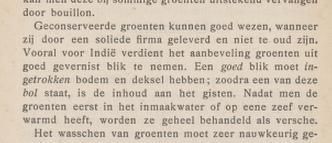Dutch Cuisine in Indonesia
- Anniversary Packaging of Canned Nasi Goreng
The importance of canned goods in the colonized world becomes apparent from the recipes in the 1928 cookbook De Hollandsche tafel in Nederlandsch-Indië.
The importance of canned goods in the colonized world becomes apparent from the recipes in the 1928 cookbook De Hollandsche tafel in Nederlandsch-Indië (The Dutch Table in the Dutch Indies). When using peas, carrots, beans and asparagus, the recipes recommend using the canned versions. The author also gives additional tips on how to check whether the canned vegetables are of good quality (fig. 1).
Or take the classic Groot Nieuw Volledig Oost-Indisch Kookboek (Big New Complete East-Indian Cookbook) by Catenius van der Heijden from 1902. The cover of the book shows us a colonial ideal: the Dutch housewife in the foreground, together with her Indonesian servant, a ghost almost, at work in the kitchen. What were they cooking? Well, this cookbook featured a lot of recipes with Dutch canned vegetables! Take for example the short but powerful instructions for cooking Brussels sprouts: to be dumped from can without water, stewed up quickly with butter, salt and nutmeg._ The recipe for hutspot (stew with carrot and onion) was even shorter: to be dumped from can and heated up with salt and pepper.
Because of the preservation of vegetables and even entire meals, the Dutch could bring flavors from home with them to Indonesia. Reversely, with the independence of Indonesia the opposite happened, and the Indonesian people brought their flavors with them to the Netherlands. The recipe for canned hutspot in Indonesia from the beginning of the 20th century mirrors that of the canned nasi in the Netherlands in the 60s.

Fig. 1 – Text from 'De Hollandsche tafel in Nederlands-Indië', 1928, p. 174. Photo by Alicia Schrikker.

Fig. 2 – Cover of J.M.J. Catenius van der Meijden, 'Groot en Nieuw Volledig Oost-Indisch kookboek, 1381 recepten' (Semarang 1902) – Photo by Bries Heijnen

Fig. 3 – Recipe page for preserved vegetables from J.M.J. Catenius van der Meijden, 'Groot en Nieuw Volledig Oost-Indisch kookboek, 1381 recepten' (Semarang 1902) – Photo by Bries Heijnen